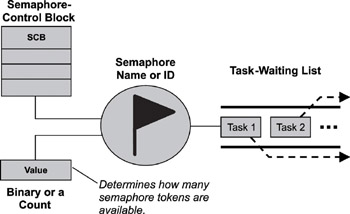Книга: Real-Time Concepts for Embedded Systems
6.2 Defining Semaphores
A semaphore (sometimes called a semaphore token) is a kernel object that one or more threads of execution can acquire or release for the purposes of synchronization or mutual exclusion.
When a semaphore is first created, the kernel assigns to it an associated semaphore control block (SCB), a unique ID, a value (binary or a count), and a task-waiting list, as shown in Figure 6.1.

Figure 6.1: A semaphore, its associated parameters, and supporting data structures.
A semaphore is like a key that allows a task to carry out some operation or to access a resource. If the task can acquire the semaphore, it can carry out the intended operation or access the resource. A single semaphore can be acquired a finite number of times. In this sense, acquiring a semaphore is like acquiring the duplicate of a key from an apartment manager-when the apartment manager runs out of duplicates, the manager can give out no more keys. Likewise, when a semaphore’s limit is reached, it can no longer be acquired until someone gives a key back or releases the semaphore.
The kernel tracks the number of times a semaphore has been acquired or released by maintaining a token count, which is initialized to a value when the semaphore is created. As a task acquires the semaphore, the token count is decremented; as a task releases the semaphore, the count is incremented.
If the token count reaches 0, the semaphore has no tokens left. A requesting task, therefore, cannot acquire the semaphore, and the task blocks if it chooses to wait for the semaphore to become available. (This chapter discusses states of different semaphore variants and blocking in more detail in "Typical Semaphore Operations", section 6.3.)
The task-waiting list tracks all tasks blocked while waiting on an unavailable semaphore. These blocked tasks are kept in the task-waiting list in either first in/first out (FIFO) order or highest priority first order.
When an unavailable semaphore becomes available, the kernel allows the first task in the task-waiting list to acquire it. The kernel moves this unblocked task either to the running state, if it is the highest priority task, or to the ready state, until it becomes the highest priority task and is able to run. Note that the exact implementation of a task-waiting list can vary from one kernel to another.
A kernel can support many different types of semaphores, including binary, counting, and mutual-exclusion (mutex) semaphores.
- Chapter 6: Semaphores
- 4.3 Defining an RTOS
- Defining mail transport protocols
- 1.1.4 Defining the Embedded System
- 5.2 Defining a Task
- 6.2.1 Binary Semaphores
- 6.2.2 Counting Semaphores
- 6.2.3 Mutual Exclusion (Mutex) Semaphores
- 6.3.1 Creating and Deleting Semaphores
- 6.3.2 Acquiring and Releasing Semaphores
- 7.2 Defining Message Queues
- Defining a Class




